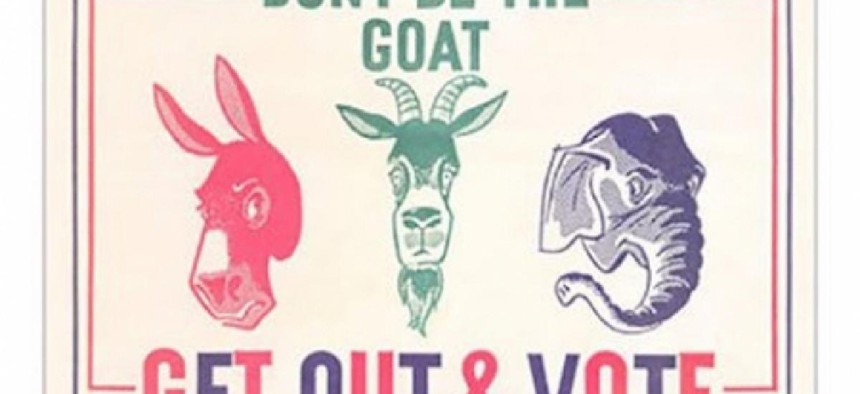Elections (Archived)
Opening up solutions to Pennsylvania's primary problem

image from Twitter
Donald Trump is right: Elections in the United States are fixed. But he is wrong about how they are fixed, who is doing the fixing, and what it is doing to our democracy.
Trump says that millions of illegal voters are stuffing our national ballot boxes with illicit votes. But that particular myth has now been debunked by a phalanx of scholars, election administrators, and other public officials, both Democrats and Republicans. Few major issues today enjoy near-unanimous bipartisan consensus; this one does.
Trump’s dark fantasy about widespread illegal voting is a crock. He is right, however, that elections are fixed – but he is right for the wrong reason.
Our elections are fixed not by mythical illegal voters. Indeed, we need more voters, more turnout and more participation in our politics. Instead, it’s our own political institutions, including our political party primary systems, that increasingly create and reinforce the toxic malaise pervading contemporary politics.
Our electoral system is a “two-party system” – meaning that two major political parties, i.e. the Republican Party and the Democratic Party, win most of the elections, make most of the policy and monopolize most of the power. In reality, “most” is usually “all” as “third parties” and “Independents” rarely win elections or exercise power in our system. Competition, to the extent it exists, is between the two major parties.
From the beginning of the two-party system in the 1790s, this meant the major parties needed a system to nominate candidates to run in state, congressional and presidential general elections. Successive systems known, respectively, as “caucuses,” “conventions” and, finally, “direct primaries,” were used to nominate candidates. The current system used for most American elections is the direct primary that first gained popularity in the early 20th century.
Far from “democratic,” it still was more democratic than either the caucus or convention because it allowed rank-and-file voters to select (nominate) party candidates.
Over time, individual states adopting the primary system opted for either “open” or “closed” primaries. The open primary, with some variants, allows any registered voter to vote in the party primary of their choice regardless of whether they are registered with another party or no party at all. The advantage of open primaries is they increase participation, draw a wider swath of voters and are more representative of the electorate as a whole.
Closed primaries, on the other hand, exist in just 11 states. Pennsylvania is one of them. The argument for them is that they allow the major parties to control those that can vote in that party’s primary.
The reality of closed primaries is much more ominous. In practice, they tend to attract mostly committed, deeply involved voters, who in turn favor candidates toward the ideological extremes – far right for Republicans and far left for Democrats. This often leaves more moderate voters without a candidate to strongly support.
According to the Pew Research Center, a majority of voters are moderates while a minority are “the most deeply partisan and ideological…” However, it is precisely this deeply partisan minority that tends to vote in Pennsylvania primaries – while the relatively voiceless 80 percent tend to be the moderates who don’t or can’t vote. As Pennsylvania’s Senate President Pro Tempore Joe Scarnati recently remarked: “The extremes of the parties have taken over the primary process.” Voters in the general election today remind one of the famous Henry Ford statement about Ford automobile buyers: They can paint their car “any color so long as it is black.” Voters in the fall general today can vote for any candidate they want as long as he or she isn’t very moderate.
Closed primaries effectively disenfranchise a majority of voters. Indeed, some 1.2 million registered Pennsylvanians are completely shut out of the process. Even if voters excluded in the spring do vote in November, their choice is limited to candidates chosen by someone else. This year some 80% of eligible voters were voiceless while the other 20% picked the nominees who will be on the November ballot.
Happily, more and more states have adopted the open primary system to minimize voter disenfranchisement. Even the Pennsylvania legislature is considering a system that would allow “Independents” and unaffiliated to vote in primaries.
Pennsylvania, however, is notoriously slow to change and much work needs to be done to bring about even modest reform. The stakes are high. Our country is being torn apart by ideologues of both parties while more moderate, less extreme and less polarized voters are relegated to the sidelines.
Opening up the primary system offers no panacea. It is no magic wand, as other changes such as anti-gerrymandering reapportionment reform, and increased voting participation must also come. But adopting an open primary would be a big step on a long road – a road that will only grow longer the longer we delay.
Dr. G. Terry Madonna is Professor of Public Affairs at Franklin & Marshall College, and Dr. Michael Young is a speaker, pollster, author, and was Professor of Politics and Public Affairs at Penn State University. Madonna and Young encourage responses to the column and can be reached, respectively, at terry.madonna@fandm.eduand drmikelyoung@comcast.net.
